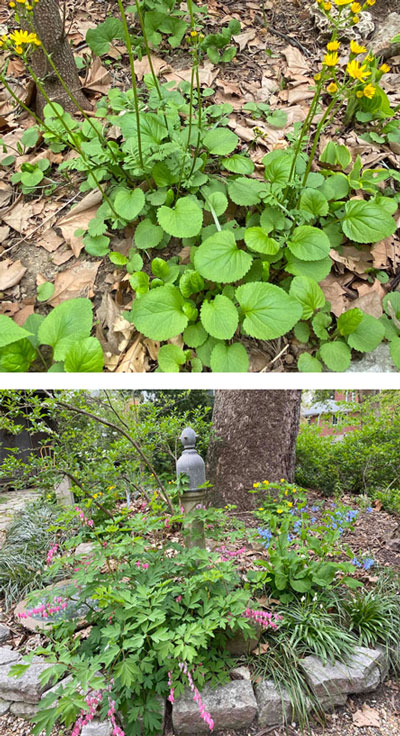
By Jean Ponzi
Photo captions: (top) Native spring ephemerals, delicate colors.
(bottom) Golden Groundsel, a native ground cover.
I talk about them all the time!
Eco-Logical Landscaping with Native Plants has grown to be my ultra-fave Green educational focus. I will happily advocate this for the rest of my vocational life.
And I don’t just talk about native plants, I grow them.
Native plants and I get to mess around, move around, experiment with rooting into happy places. I still clock in once a month or so mowing grass, but my labor with our native plant neighbors is FUN work, anytime. And fun learning.
Last year, I officially gave up on any plant needing sun to flower.
Our place is a forest. We “garden” with trees. My dream of a riot of prairie flowers is a delusion. Coneflowers, Blazing Stars, Queen of the Prairie – all have faded and withered away in our deep shade. Leafy cover is lovely in our summer heat, but how many years did I choose plants oblivious to who could thrive here? How many sun-loving species did I ignorantly trowel in? Countless. Sunless. History.
When last year’s native plant sales came around (order online, drive-thru pickups) I skimmed the lists for Shade, Shade, Shade.
As always before, I met new plant friends: Purple Rocket, Jacob’s Ladder. A variety of Blue Star that scintillates in Shade!
Growing awareness benefits all. One of our planting beds, close to the house, is alight this spring with ephemeral color: the periwinkle twinkle of Virginia Bluebells, rosy glow of a Bleeding Heart, lacy pink and white dogwood trees, and the sunny yellow of Celandine Poppies. Thank you, dappled shade of spring.
Once established, native plants want little tending, but my human hand is needed still. In our rich city soil, those poppies are taking over! Fuzzy pods, yellow blooms and ruffled leaves are everywhere. I dig them up, share them – even compost them with clear mind and willing heart. They are beautiful, but too much of anything chokes out others.
Thank you, Celandine Poppies, for decision-making practice.
One treasure is our cluster of Trilliums.
This plant was my first endangered species. I was little, not even five. My family was walking in woods, on property my grandparents bought, thinking they might build a house. The project never materialized, but my lesson seeing Trilliums presaged eco-awareness to come.
Of course, seeing a flower, I reached to pick. Mom stopped me: “This plant is rare and protected! Not very many of them are left. If you pick it, you will hurt them all.”
Years before the Endangered Species Act, I learned how human actions can imperil plants. Today I can host Trilliums, and still don’t pick them. Now I know the function of flowers: perpetuating plant species. Much more satisfying than something in a vase.
The corner by our compost pile is nodding with yellow from a calmly creeping friend, Golden Groundsel.
I learned about this plant when I oversaw the grounds around the EarthWays Home, the central-city sustainability education site where my Missouri Botanical Garden team worked from 2000 to 2010. A stretch of the front of our property was steep and dry. Nothing wanted to grow there. I came this close to paving it over and painting the concrete green.
My colleague Scott Woodbury, who is Curator of Native Plants at Shaw Nature Reserve (and an internationally recognized authority on native plant landscaping!) suggested Sinecio obavatus, a plant then known as Squaw Weed. Cultural sensitivity and botanical evolution re-named this species: Packera aurea, or Golden Groundsel.
I took Scott’s advice and dug in a flat of this handsome plant. Scallop-edged round leaves form a pleasing whorl. A stalk shoots up in early spring that bursts into clusters of daisy bloom, the cheerful colors of butter and cheese. A couple of weeks went by – and the cheese lived!
While this plant was settling in, I visited friends at their cabin on Brazil Creek, an hour toward the Ozarks from St. Louis. Walking in their woods on a fine spring day I spotted an individual I knew.
“Sinecio obavatus!“ I cried. “It’s growing wild!” Hello, Jean. Duh. This native plant is a wild flower.
Wild native plants are taming us, as we learn to grow together.
Jean Ponzi celebrates Nature in human conversations, and her daily work. Pick up her podcast Earthworms from KDHX St. Louis Independent Media, and check out the work of EarthWays Center of Missouri Botanical Garden.


